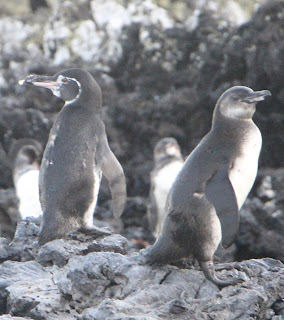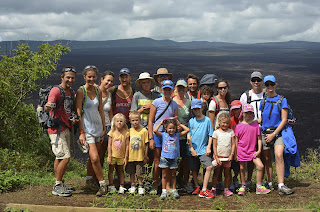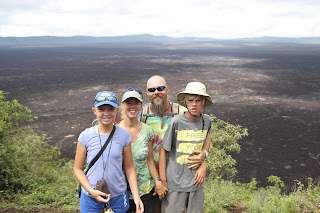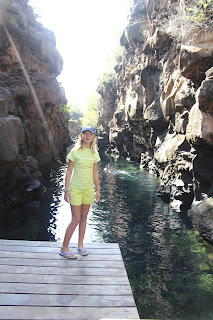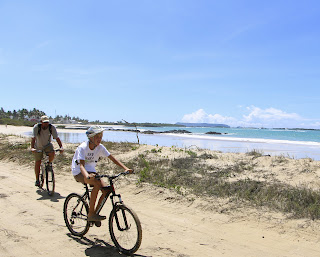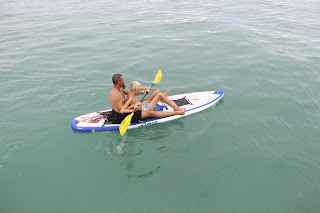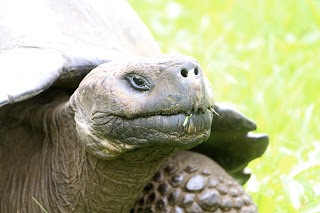***********************
Meghan on Amelie (Written on April 8th 2015)
For those of you reading this from the northern hemisphere, you are now on the opposite side of the world that I am now! We are actually basically in the middle of the globe now since we are a little bit south of the equator in the famous, wild Galapagos Islands!
Being “Inside” Evolution
For those of you who don’t know, it was by visiting the Galapagos that famous geologist Charles Darwin came up with the theory of evolution. The ship he was on, called the Beagle, made a quick 5 week stop in these islands on his way around the world. Before the Beagle, the other ships that came claimed the Galapagos a desolate, wasteland so we are quite lucky that Charles Darwin saw something different because we may still have thought today it was a waste of our time to bother discovering further into these incredible magical islands.
I have been to places before where they have fascinating animals but that they are really hard to find and the moment you yell, “Found one!,” they dart away into the bush. I was expecting the same here in Galapagos but I was in for a whole different experience. I have never actually had an animal approach me without any hesitation once or ever like I have here.
First of all, there are the sea lions. Again, I was really expecting to have to look for many days and take a couple of hikes or something to find these guys but one walk into the town in San Cristobal flew that out of my brain. When, we first got to the dinghy dock, I saw some around and on the dock which wasn’t too surprising but still kind of cool. Then we walked up the ramp and we saw some on the rocks next to the sidewalk which was a bit shocking considering how close the sidewalk was to the rocks. But then, as we walked further, we saw some on the benches, walking on the sidewalk, under tables, all over the beaches, in the dried up fountain and even on the outdoor stage! When they would waddle on the sidewalk, we would actually scream a little bit and move out of their way while they were just acting as if it were completely normal and just waddled past us.
At night, they all come up onto shore to sleep. After watching them for a long time on the beach, I realized that they act very much like humans when they go to sleep. The way they spread themselves out and lay down looked just like me except I’m not brown with 4 flippers. Also, some of them snuggle together to sleep and they even have a designated nursery for the babies who are one and older (until they are adults).
They will also sleep on benches, rocks, sidewalks and a flight of stairs that lead down to the water. One night, when there were many sea lions on the stairs, two got into an argument. It was a baby and a male and it actually got so carried away that we heard them barking, barking, barking until all of a sudden…. splash! The male had nudged the baby all the way off the edge into the water! Then, the baby started barking for his mom to come help him but she was at the top of the stairs so she had to roll down all the sea lions (who were not very happy about that) to get to the bottom to help her baby up. It was just so fascinating to watch them trouble shoot because it was so human.
They are also super smart. When we were swimming with one, it would splash a little bit because it knew that splashing was a form of playing. Also, when we were at a beach, we saw one body surfing on it’s belly by pulling its fins back!
Sea lions are just one of the thousands of creatures in Galapagos. We haven’t seen them all but I think my favourite have to be the giant land tortoises. They may be slow but the way they have evolved is mind blowing. Each type of land tortoise on each island has evolved differently. I think though the most amazing thing about them is that they can last a year without any food or water at all!
As well as being giant (adults can be about 5-5 1/2 feet long), the tortoises also have a very long lifespan. They can live up to 150 years old! At the tortoise sanctuary on Isabela island, we saw some miniature, newborn babies and it was amazing to think that we would all be long dead before they are! They are going to have to hire new employees at the sanctuary before the babies are adults! What I can’t seem to figure out though is how their shells grow with them (because they do).
We were actually lucky enough at the tortoise sanctuary on San Cristobal island to see two fight! It was really interesting (and slow as you can imagine!) because at first, the angry one pulled it’s neck up high and hissed at the other one making the victim hide his head in his shell. Then, once the victim took his head out again, the angry one tucked his own head in and shoved the other one away far enough until he was satisfied! What I found quite funny is that the victim just pretty much went along with it and went completely back to normal after the fight.
My second favourites would have to be the marine iguanas. They look pretty much like regular iguanas but they can swim comfortably down to 20 ft for 10 minutes to get their food until they have to go back up on the rocks to get warm again since they are cold blooded. The swimming part is actually the simple part of the process to get their food. They first jump off their high rocks into the breaking waves (which would either seriously injure or kill us humans if we did that) and then once they have their food, they have to swim past the sea lions who like to tease them playfully which ends up slowing them down. Shockingly, when the marine iguanas were first swept here from South and Central America, they were actually land iguanas but over time, they have evolved to swim! They don’t actually use their feet when they swim, they just tuck them to the side and move only their tail. When they eat though, they swallow too much salt so they snort it out after which is pretty cool to see (I can’t imagine it’s very cool to feel on your skin though). The land iguanas were pretty funky themselves since they were all yellow and red!
The other land animals we saw were all birds. To start off with, there are Darwin’s famous finches! For those of you who don’t know, when Darwin came to the Galapagos, he was particularly fascinated by the finches since every island’s finch had a different beak depending on what they ate and their habitat. It was by studying these finches that Charles Darwin developed his theory of evolution. Now, today the 13 different kinds of finches are named after him.
Another common type of bird in the Galapagos is the booby (yes, that is actually a type of bird). There are three types of boobies in the Galapagos; the blue footed boobies, the red footed boobies and the nazca boobies but the most common are blue footed and the nazca boobies. All three of these types are endemic to Galapagos!
Blue footed boobies’ name basically tells you how to identify it. I am not just talking about a faded blue which you can kind of see if you look close enough, I am talking about bright blue bubblegum feet that you can see from 30 ft away!
Red footed boobies were my favourite and we were very lucky to see them because only 10% of the tourists who come to Galapagos are able to! We took a tour up to the north end of San Cristobal island to this completely untouched desert like land where the red footed boobies lived. Sure enough, we were able to see many of them and even got to see some sitting on their eggs or feeding their young in the nests only about 3 feet off the path!
Most of you probably won’t believe it but there are penguins here in Galapagos! When someone first told me that (before we came here), I didn’t believe them at all but turns out they were right because we saw them with our own eyes. The cool water near the equator attracts them from the South. They are very small (about 30-40 cm tall) and incredibly adorable especially when they shook their little feathers off after swimming. We didn’t have a chance to swim with them but we heard from our friends that they are very playful and they swim all around your legs but it is impossible to film them because they move so fast!
The marine animals also were astounding. Since we are not allowed to fish in Galapagos, the reefs are so rich, I could swim in the water forever and I don’t think I would get bored of looking at the life!
If anything, the one type of animal in Galapagos I was expecting was going to be scared of us was fish. I was right about most of them but there were a few types of fish that weren’t really. They would swim near the surface and when I would put my camera near them, they wouldn’t really dart away like all the other fish do. I was really excited when a whole school of hundreds of small fish made a circle around me because I’ve seen them do that for a sea turtle in a movie and I was hoping some could do that for me. One fish even swam up to my camera to look at it more closely!
I also got to swim with big fish called sharks! I was very excited about that because were hammerhead sharks that I was surprised got only as big as about 4.5 ft so I wasn’t scared at all but trust me, if it had been a tiger shark or a great white shark, I would have had a different story. As well as hammerheads, we also saw several black and white tip reef sharks (also only about 2-4 ft big).
I saw some new types of rays here in Galapagos too like the eagle ray. Eagle rays are black with white spots and have a big head that looks kind of like an eagle’s head. We also think we may have seen a couple of manta rays when off the boat on our way to different islands but we are not 100% sure if they were and we will never be but just the chance that we may have seen a manta ray amazes me!
Lastly, of course, there are the sea turtles. I learned on my dive course in St. Maarten that you always have to stay at least 2 metres away from a sea turtle or else they will get scared and they may forget to go to the surface (which would kill them) and I always followed that rule whenever I saw turtles but in the Galapagos, I was swept almost right into one by accident and it could not care less! The sea turtles in Galapagos are so trusting with humans and they are also not very agile, mostly just relaxed and peaceful. Now I see why in Nemo, they took that stereotype to make their turtles because Crush is one easy-going dude! At Loberia beach on San Cristobal island, we actually witnessed what we called a “sea turtle cleaning station” where all the fish seemed to be eating parasites off the turtles while the turtles just moved back and forth with the waves.
The different landscapes in Galapagos are equally as astonishing as the creatures. They vary from sandy white beaches to rich, green forests or from rocky, volcano craters to wetlands and lagoons. There are few towns in all of the Galapagos which is special because there are not many places left in the world which over 90% of the land is untouched by humans! Here are some pictures of the different perfect terrains we saw.
I hope I gave you all a little idea of the Galapagos and maybe now you can plan this as your next vacation destination! The next time I write a blog entry, I will be halfway across the pacific ocean because our next stop is French Polynesia! From in the middle of nowhere, your sailing friend, Meghan.
***********************************
Meg and M-C had a beautiful day visiting a smaller island, Bartholome, where we saw colourful , awe inspiring volcanic plains, and swam with penguins. They flew like torpedoes above our heads ! The whole family had a great time in Santa Cruz, visiting Las Grietas, (high cliff formations in which you could swim), and learning some more about Charles Darwin and his theory of Evolution. We went for several hikes in lush forests, and walked through enormous lava tunnels. We had a few more encounters with the giant tortoises and even spotted a few of Darwin's finches ! A few days before leaving we visited a local farm, where we stocked up on fresh foods, eggs fruit and vegetables to ready ourselves for our longest crossing yet ! We hate to leave these enchanted Galápagos, but French Polynesia beckons us !
